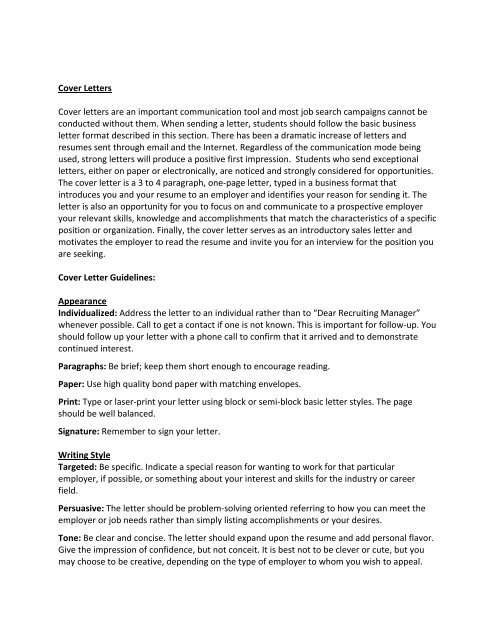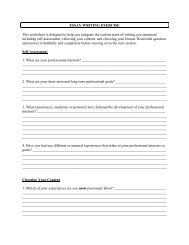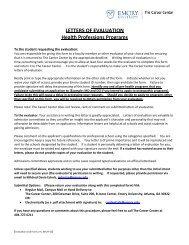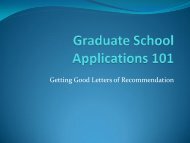Cover Letter Writing Guide
Cover Letter Writing Guide
Cover Letter Writing Guide
You also want an ePaper? Increase the reach of your titles
YUMPU automatically turns print PDFs into web optimized ePapers that Google loves.
<strong>Cover</strong> <strong>Letter</strong>s<strong>Cover</strong> letters are an important communication tool and most job search campaigns cannot beconducted without them. When sending a letter, students should follow the basic businessletter format described in this section. There has been a dramatic increase of letters andresumes sent through email and the Internet. Regardless of the communication mode beingused, strong letters will produce a positive first impression. Students who send exceptionalletters, either on paper or electronically, are noticed and strongly considered for opportunities.The cover letter is a 3 to 4 paragraph, one‐page letter, typed in a business format thatintroduces you and your resume to an employer and identifies your reason for sending it. Theletter is also an opportunity for you to focus on and communicate to a prospective employeryour relevant skills, knowledge and accomplishments that match the characteristics of a specificposition or organization. Finally, the cover letter serves as an introductory sales letter andmotivates the employer to read the resume and invite you for an interview for the position youare seeking.<strong>Cover</strong> <strong>Letter</strong> <strong>Guide</strong>lines:AppearanceIndividualized: Address the letter to an individual rather than to “Dear Recruiting Manager”whenever possible. Call to get a contact if one is not known. This is important for follow‐up. Youshould follow up your letter with a phone call to confirm that it arrived and to demonstratecontinued interest.Paragraphs: Be brief; keep them short enough to encourage reading.Paper: Use high quality bond paper with matching envelopes.Print: Type or laser‐print your letter using block or semi‐block basic letter styles. The pageshould be well balanced.Signature: Remember to sign your letter.<strong>Writing</strong> StyleTargeted: Be specific. Indicate a special reason for wanting to work for that particularemployer, if possible, or something about your interest and skills for the industry or careerfield.Persuasive: The letter should be problem‐solving oriented referring to how you can meet theemployer or job needs rather than simply listing accomplishments or your desires.Tone: Be clear and concise. The letter should expand upon the resume and add personal flavor.Give the impression of confidence, but not conceit. It is best not to be clever or cute, but youmay choose to be creative, depending on the type of employer to whom you wish to appeal.
Accuracy: Use correct grammar, punctuation and spelling. Make certain there are no mistakes.Have career counselors and/or individuals you know critique your letters.Page 2 of 3Self‐Descriptive Words(Add personal qualities to the letter)Action Words(Serve to convey a spiritedpersonality and a productive person)active independent accelerated managedadaptable logical adapted motivatedaggressive loyal administered organizedalert mature analyzed originatedambitious methodical approved participatedanalytical objective coordinated performedattentive optimistic conceived plannedperceptive broad‐minded conducted pinpointedpersonable conscientious completed programmedconsistent pleasant controlled proposedconstructive positive created provedcreative practical delegated provideddependable productive developed recommendeddiplomatic realistic directed reinforceddisciplined reliable eliminated reorganizeddiscrete resourceful established revampedeconomical respective expanded revisedenergetic sense of humor founded scheduledenterprising sincere generated set upenthusiastic sophisticated influenced structuredextroverted systematic implemented supervisedfair talentedTypes of <strong>Cover</strong> <strong>Letter</strong>s:<strong>Letter</strong> of ApplicationExplains your interest in a specific position known to be open with an employer. This letterincludes pertinent details about your qualifications and requests action regarding the position.<strong>Letter</strong> of InquiryExpresses interest in working for the employer and inquires as to whether a particular type ofposition might be available.Using Contacts in a <strong>Cover</strong> <strong>Letter</strong>Students should always mention the name of a contact whenever possible. A contact can be aprofessor, a friend’s parent or alumnus/ae. By mentioning the contact’s name, a whole newimage about the candidate is generated. The employer may conclude that the contact is
endorsing the candidate, the resume will be read, and the chance of an interview is morefavorable.(Adapted from: Career Planning Today, C. Randall Powell; Resumes That Knock'em Dead, MartinJohn Yates)Page 3 of 3Suggested <strong>Cover</strong> <strong>Letter</strong> FormatYour AddressDateContact PersonTitleDepartmentCompany NameAddressDear Mr./Mrs./Ms./Dr. (Contact Person):First Paragraph ‐ Introduction (2 ‐ 4 sentences)Establishes the purpose of your letter, attracts attention and arouses interest. Mention the name of your contact person, if applicable. State why you are writing by naming the specific position or type of job. Tell how you heard about the position/employer and why you are interested in it. Insert a brief sentence that gives your degree, major, college affiliation, and graduation date.Second/Third Paragraph ‐ Body (1 ‐ 2 paragraphs, depending on background)Generate interest with content by indicating how much employer research you have done and how yourskills/background match the employer's needs. Indicate how you can help the employer achieve organizational goals in your specialty. Focus on whatyou can do for them rather than why you want the position. Highlight your most significant accomplishments, abilities, and experiences that are specificallyrelevant to the employer and job requirements. Sell your credentials ‐ your mission is to prove you should be invited to an interview. Make referenceto enclosures. Do not simply repeat your resume but point out important experiences and key assets ‐ show some ofthis to demonstrate to the employer your more personal qualities that cannot be indicated on a resume.Fourth Paragraph ‐ Closing (4 sentences maximum)State your commitment to action. Take the initiative to make clear what happens next ‐ you will be calling to arrange an appointment,and/or ask for additional information. State your availability. Let them know if/when you will be in the area. Mention enclosed resume or sample work, if applicable. Restate contact information so the employer can reach you. Thank the employer.
Very truly yours/Sincerely,(followed by four spaces)Your SignatureYour Name Typed





